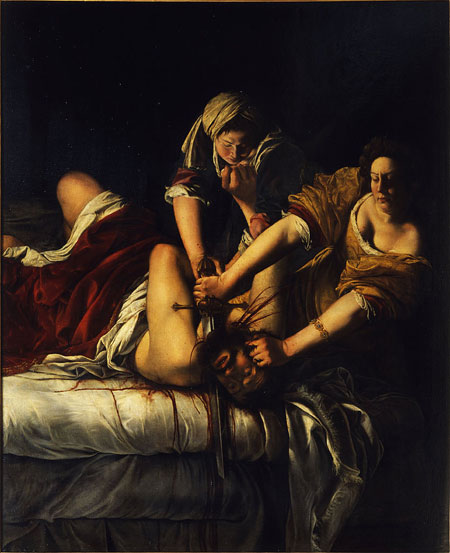Judith and Holofernes by Artemisia Gentileschi

Artemisia Gentileschi was an Italian painter, considered as one of the most accomplished and, most famous women painter, of the 17th century after Caravaggio. In an era when female painters were not easily accepted, she was the first female painter to become a member of the Accademia di Arti del Disegno in Florence.
Daughter of Caravaggio’s follower, Orazio Gentileschi, Artemisia moved to Florence to escape the scandal in Rome after the lawsuit for rape she brought against the landscape painter Agostino Tassi. Of this dramatic case, concluding predictably with the humiliation of Artemisia, documentation does exist and today is often taken as a symbol of the violence women have had to endure for centuries.
Unfortunately, those events often seem to overshadow her achievements as an artist and for long was regarded as a curiosity. Fortunately, today her work is being reevaluated and considered one of the most progressive of her generation.
In her work, Artemisia seems to have transferred her experience to canvas. Her paintings often have strong, suffering women from myth and the Bible – victims, suicides, warriors. She particularly seems to have like the Judith story, one of two paintings present at the Uffizi Gallery today.
In “Judith and Holophernes” (found in Hall 90 along with Caravaggio), the biblical heroine Judith, a traditional example of virtue and chastity, is shown about to decapitate her despised Assyrian enemy whom she has tricked by seduction while keeping her purity safe. The canvas was probably painted for Cosimo II de’ Medici and completed in Rome immediately after Artemisia’s return there after having spent 7 years in Florence. It is signed at the lower right: “Ergo Artemitia Lomi Fec.”
Due to its violence, the work was confined to a “dark corner” in the Pitti Palace and only after Cosimo II’s death was Artemisia even paid for her work, with the help and mediation of her friend Galileo.
At the Uffizi, you can also admire another work by Artemisia, “Saint Catherine of Alexandria“, smaller in size compared to “Judith and Holophernes“. In several of her paintings, Artemisia’s heroines have a similar appearance to her self-portraits; in “Saint Catherine of Alexandria” we are reminded of her as well.
Going back to the Judith story, you can admire Artemisia’s “Judith and her Maidservant” at the nearby Pitti Gallery in Florence.









